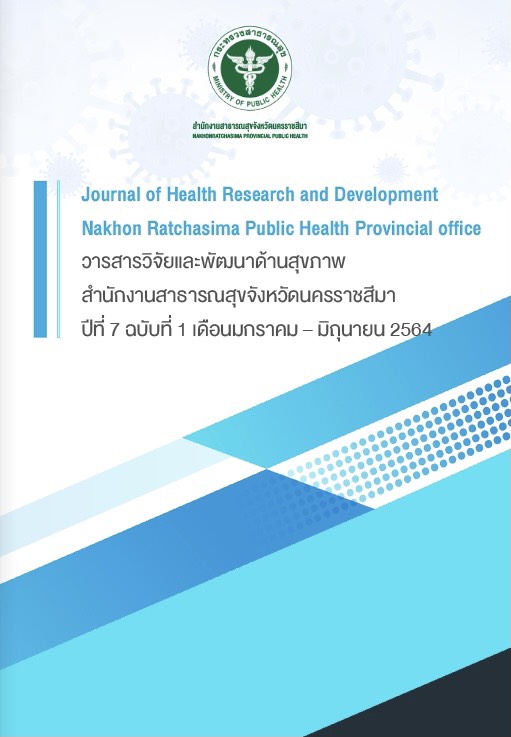การเปรียบเทียบการผุเพิ่มและการคงอยู่ภายหลังการบูรณะฟันกรามน้ำนมด้วยวิธี SMART ระหว่างการบูรณะฟัน Class I และ Class II
คำสำคัญ:
การบูรณะฟันกรามน้ำนมด้วยวิธี SMART, การผุเพิ่มภายหลังการอุดฟันกรามน้ำนมด้วยวิธี SMART, การคงอยู่ภายหลังการบูรณะฟันกรามน้ำนมด้วยวิธี SMARTบทคัดย่อ
การวิจัยครั้งนี้เป็นการวิจัยแบบกึ่งทดลอง มีวัตถุประสงค์เพื่อเปรียบเทียบการผุเพิ่มตามขอบของวัสดุอุดและการคงอยู่ของวัสดุอุดระหว่างการบูรณะฟันแบบ class I และclass II ภายหลังการบูรณะฟันกรามน้ำนมด้วยวิธี SMART เป็นระยะเวลา 6 เดือน กลุ่มตัวอย่างมาจากการเลือกแบบเจาะจงในเด็กอายุ 3-5 ปี ที่อาศัยในเขตอำเภอสีคิ้ว ที่มีฟันผุ จำนวน 114 คน 125 ซี่ แบ่งเป็นการบูรณะแบบ Class I 77 ซี่ Class II 48 ซี่ ผู้วิจัยตรวจฟันและวัสดุอุดภายหลังการบูรณะฟัน 6 เดือน เก็บข้อมูลระหว่าง 1 มกราคม ถึง 31 กรกฏาคม 2563 เครื่องมือที่ใช้ในการวิจัยได้แก่ เครื่องมือในการตรวจฟันและวัสดุอุดและแบบบันทึกผลการบูรณะฟันด้วยวิธี SMART เกณฑ์การประเมินวัสดุและรอยผุใช้เกณฑ์จากแบบบันทึกผลการบูรณะฟันด้วยวิธี SMART ของ รศ.ทพ.ประทีป พันธุมวนิช วิเคราะห์ข้อมูลด้วยสถิติพรรณา และไคว์สแควร์ (Chi-square) การศึกษา พบว่า การบูรณะฟันกรามน้ำนมด้วยวิธี SMART มีการผุเพิ่มตามขอบของวัสดุอุดในภาพรวมร้อยละ 5.6 ไม่พบความแตกต่างอย่างมีนัยสำคัญทางสถิติของการเกิดการผุเพิ่มระหว่าง การบูรณะแบบ Class I (ร้อยละ2.6) และClass II (ร้อยละ10.4) ด้านการคงอยู่ของวัสดุอุดในภาพรวม พบว่าวัสดุอุดคงอยู่ทั้งหมด ร้อยละ 73.6 โดย ใน Class I (ร้อยละ 84.4) วัสดุอุดคงอยู่มากกว่า ใน Class II (ร้อยละ 56.3) อย่างมีนัยสำคัญทางสถิติ ไม่มีตำหนิบริเวณรอยต่อของฟันกับวัสดุอุด ร้อยละ 71.2 โดยใน Class I (ร้อยละ 81.8) มีขอบของวัสดุ ที่ดี มากกว่า ใน Class II (ร้อยละ 54.1) อย่างมีนัยสำคัญทางสถิติ ไม่มีการสึกของวัสดุร้อยละ 70.4 โดยใน Class I (ร้อยละ 81.8) มากกว่า ใน Class II (ร้อยละ 52) อย่างมีนัยสำคัญทางสถิติ ไม่มี การเปลี่ยนสีของวัสดุร้อยละ 98.4 (กลุ่ม class I ร้อยละ 98.7 และ กลุ่ม class II ร้อยละ 97.9) พบว่าการเปลี่ยนสีของวัสดุและรูปแบบในการบูรณะฟัน (Class I และ Class II) ไม่มีความสัมพันธ์กัน
เอกสารอ้างอิง
รายงานผลการสำรวจสุขภาวะช่องปากแห่งชาติ ครั้งที่ 8 ประเทศไทย พ.ศ.2560 นนทบุรี: สำนักทันตสาธารณสุข กรมอนามัย กระทรวงสาธารณสุข; 2561.
สุทธิรัศม์ พรรณพราว สุภาภรณ์ ฉัตรชัยวิวัฒนา และอาริยา รัตนทองคำ และคณะ. โรคฟันผุในเด็กปฐมวัย. North-EasternThai Journal of Neuroscience 2561; 12(2): 28 – 37.
คมดาว เติมกลีบบุปผา และอวิรุทธ์ คล้ายศิริ. บทความปริทัศน์กลาสไอโอโนเมอร์ซีเมนต์และสมบัติทางคลินิก. ธรรมศาสตร์เวชสาร 2560; 17(2) เมษายน – มิถุนายน: 205 – 13.
Mitra SB. Adhesion to dentin and physical properties of a light cured glass-ionomer liner/ base. J Dent Res 1991; 70(1): 72– 4.
Yoshida Y, Van Meerbeek B, Nakayama Y, Snauwaert J, Hellemans L, Lambrechts P, et al. Evidence of chemical bonding at biomaterialhard tissue interfaces. J Dent Res 2000; 79(2): 709 – 14.
Claude Levi-Strauss. Glass ionomer cements. In: Harry F. Albers, Editor. Tooth-colored restoratives principles and techniques. 9th ed. London : BC Decker Inc; 2002.
Billington RW, Pearson GJ and Williams JA. Uptake of fluoride ions by the glass component of glass ionomer cement. J Dent 2007; 35(5): 452 – 5.
Carey CM, Spencer M and Gove RJ, Eichmiller FC. Fluoride release from a resin-modified glass-ionomer cement in a continuous-flow system: effect of pH. J Dent Res 2003; 82(10): 829 – 32.
Lucas ME, Arita K and Nishino M. Toughness, bonding and fluoride release properties of hydroxyapatite-added glass ionomer cement. Biomaterials 2003; 24(21): 3787 – 94.
Pin ML, Abdo RC and Machado MA, et al. In vitro evaluation of the cariostatic action of esthetic restorative materials in bovine teeth under severe cariogenic challenge. Oper Dent 2005; 30(3): 368 – 75.
Wilson AD, Crisp S, Ferner AJ. Reaction in glass-ionomer cements: IV. Effect of chelating comonomers on setting behavior. J Dent Res 1976; 55(3): 489 – 95.
Mahesh Singh TR, Suresh P, Sandhyarani J, Sravanthi J. Glass ionomer cements (GIC) in dentistry: A review. Int J Pl An and Env Sci 2011; 1(1) : 26 – 30.
McLean JW, Gasser O. Glass-cermet cements. Quint Int 1985; 16(5): 333 – 43.
Mount GJ. An atlas of glass-ionomer cement: a clinician’s guide. 3rd ed. London: Martin Dunitz Ltd; 2002.
Saito S, Tosaki S and Hirota K. Characteristics of glass ionomer cements. In: Davidson CL, Mjor IA, editors. Advances in glass ionomer cements. Chicago: Quintessence; 1999.
Walls A. Glass polyalkenoate (glass ionomer) cements: a review. J Dent 1986; 14(1): 231 – 6.
Berg JH. Glass ionomer cements. Pediatr Dent 2002; 24(5): 430 – 38.
ทพ.ประทีป พันธุมวนิช.การอุดฟันคุณภาพแบบสมาร์ตๆที่ไม่เจ็บปวด. นิตยสารหมอชาวบ้าน 2557; 35(418): 52 – 3.
ณัฐกาญจน์ ภาคยวงศ์. การอุดฟันกรามน้ำนมแบบอะทรอมาติกโดยหน่วยทันตกรรมเคลื่อนที่อำเภอสามชุก สุพรรณบุรี: การประเมินผลระยะ 6 เดือน.วิทยาสารทันตสาธารณสุข 2560; 22(1): 27 – 36.
van Gemert-Schriks MC, van Amerongen WE and ten Cate JM, et al. Three-year survival of single- and two-surface ART restorations in a high-caries child population. Clin Oral Investig 2007; 11(4): 337 – 43.
Lo ECM and Holmgren CJ. Provision Of atraumatic restorative treatment (ART) restorations to Chinese pre-school children- a 30-month evaluation. Int J Paediatr Dent 2001; 11(1): 3 – 10.
da Franca C, Colares V and Van Amerongen E. Two-year Evaluation of the Atraumatic Restorative Treatment Approach in Primary Molars Class I and II Restorations. Int J Paediatr Dent 2011; 21(4): 249 – 53.
Phonghanyudh A, Phantumvanit P, Songpaison Y, et al. Clinical evaluation of three caries removal approaches in primary teeth: a randomized controlled trial. Community Dent Health 2012; 29(2): 173 – 8.
van Gemert-Schriks MC, van Amerongen WE and ten Cate JM, et al. Three-year survival of single- and two-surface ART restorations in a high-caries child population. Clin Oral Investig 2017; 11(4): 337 – 43.
Carvalho TS, Sampaio FC and Dinniz A, et al. Two years survival rate of class II ART restorations in primary molars using two ways to avoid saliva contamination. Int J Paediatr Dent 2010; 20(6): 419 – 25.
นฤพนธ์ อึ้งอุปละชัย และสิรกันยา สิงห์ศรี. การประเมินผลการรักษาและควบคุมฟันกรามน้ำนมผุด้วยวิธี SMART ในศูนย์พัฒนาเด็กเล็กและอนุบาล อำเภอธาตุพนม จังหวัดนครพนม.วารสารโรงพยาบาลนครพนม 2559; l3(2): 75 – 83.
ดาวน์โหลด
เผยแพร่แล้ว
รูปแบบการอ้างอิง
ฉบับ
ประเภทบทความ
สัญญาอนุญาต
บทความที่ได้รับการตีพิมพ์เป็นลิขสิทธิ์ของสำนักงานสาธารณสุขจังหวัดนครราชสีมา กระทรวงสาธารณสุข
ข้อความที่ปรากฏในบทความแต่ละเรื่องในวารสารวิชาการเล่มนี้เป็นความคิดเห็นส่วนตัวของผู้เขียนแต่ละท่านไม่เกี่ยวข้องกับสำนักงานสาธารณสุขจังหวัดนครราชสีมา และบุคลากรท่านอื่นๆในสำนักงานฯ แต่อย่างใด ความรับผิดชอบองค์ประกอบทั้งหมดของบทความแต่ละเรื่องเป็นของผู้เขียนแต่ละท่าน หากมีความผิดพลาดใดๆ ผู้เขียนแต่ละท่านจะรับผิดชอบบทความของตนเองแต่ผู้เดียว



